Taxation Law Assignment - Assessment of Tax Liability for Individuals
VerifiedAdded on 2020/03/16
|11
|1743
|145
Homework Assignment
AI Summary
This taxation law assignment analyzes the tax liabilities of Jordan, Cameron, and Cate, focusing on income, deductions, and relevant tax rulings in Australia. The assignment addresses the assessable income of Jordan and Cameron, including salary, fringe benefits, and rental income, considering the implications of the ITAA 1997. It examines allowable deductions such as work-related expenses, interest on investment properties, and the non-deductibility of child care and private living expenses. The assignment also explores the tax implications for Cate, a minor, and the deductibility of expenses related to employing her for administrative work. The analysis considers various cases and rulings, including Hayley v. FC of T, Jayatilake v FC of T, and IT 2489, to determine the tax liabilities and permissible deductions. The assignment provides a comprehensive overview of Australian taxation law, covering key concepts such as assessable income, allowable deductions, and the application of relevant tax legislation.
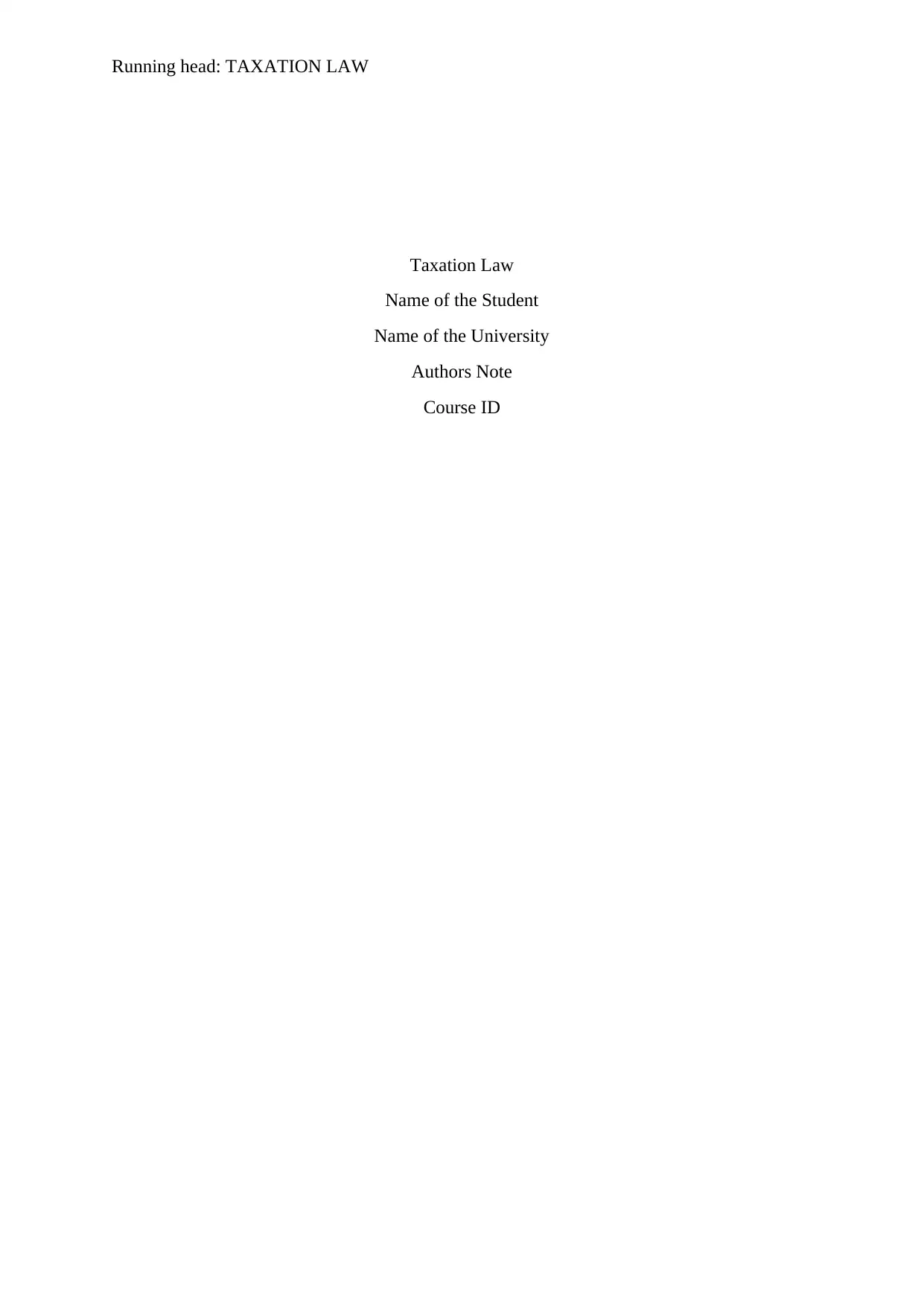
Running head: TAXATION LAW
Taxation Law
Name of the Student
Name of the University
Authors Note
Course ID
Taxation Law
Name of the Student
Name of the University
Authors Note
Course ID
Paraphrase This Document
Need a fresh take? Get an instant paraphrase of this document with our AI Paraphraser
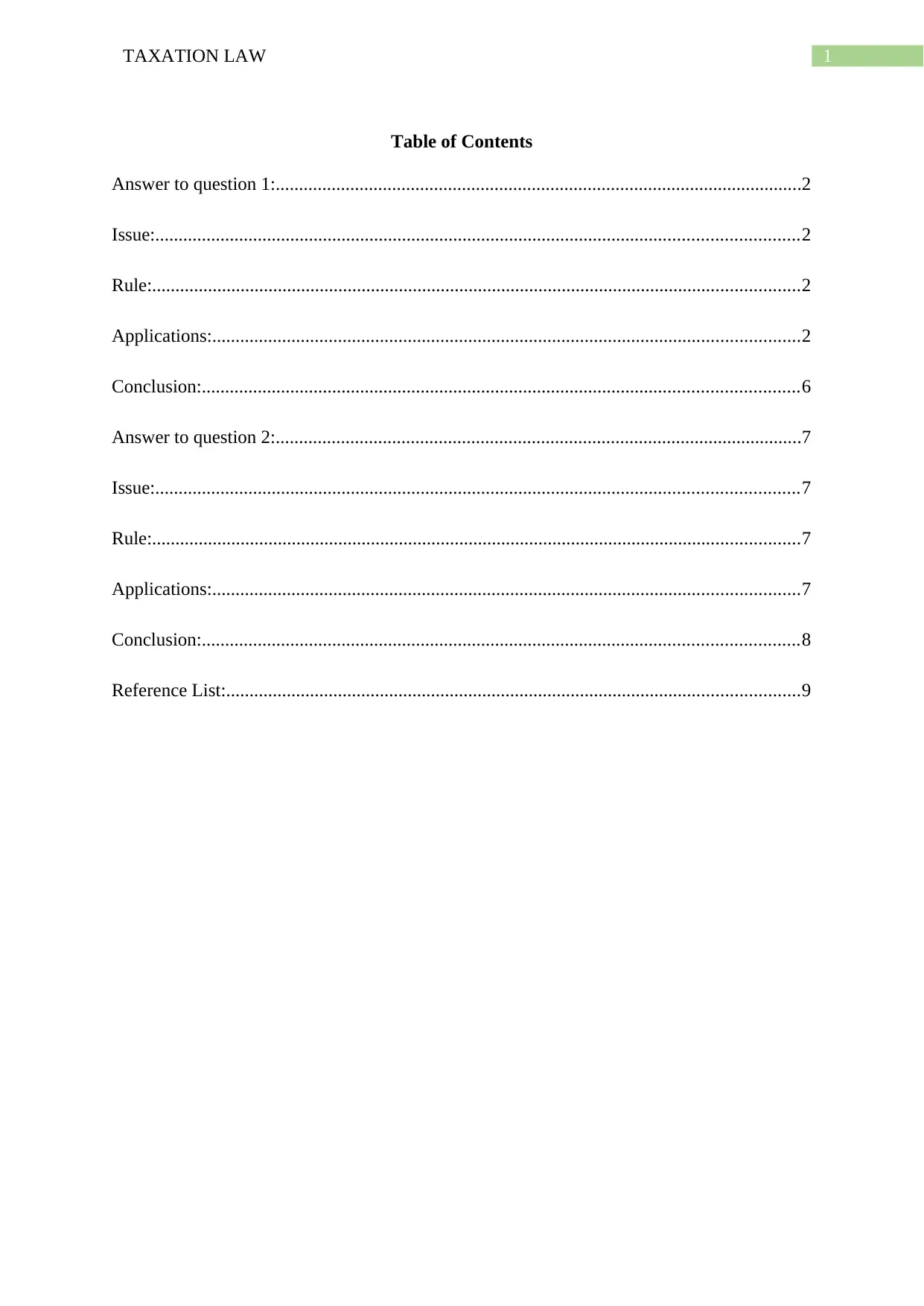
1TAXATION LAW
Table of Contents
Answer to question 1:.................................................................................................................2
Issue:..........................................................................................................................................2
Rule:...........................................................................................................................................2
Applications:..............................................................................................................................2
Conclusion:................................................................................................................................6
Answer to question 2:.................................................................................................................7
Issue:..........................................................................................................................................7
Rule:...........................................................................................................................................7
Applications:..............................................................................................................................7
Conclusion:................................................................................................................................8
Reference List:...........................................................................................................................9
Table of Contents
Answer to question 1:.................................................................................................................2
Issue:..........................................................................................................................................2
Rule:...........................................................................................................................................2
Applications:..............................................................................................................................2
Conclusion:................................................................................................................................6
Answer to question 2:.................................................................................................................7
Issue:..........................................................................................................................................7
Rule:...........................................................................................................................................7
Applications:..............................................................................................................................7
Conclusion:................................................................................................................................8
Reference List:...........................................................................................................................9

2TAXATION LAW
Answer to question 1:
Issue:
The following circumstances brings forward the issue of the amount of tax that is
payable by Jordan and Cameron. The case study evidently puts forward the evidences from
the balance sheet of Jordan and Cameron regarding the tax liability of the transactions
occurred by them. The present tax assessment will consider the receipt of income and will
additionally exclude the expenditures in arriving at the taxable income of Jordan and
Cameron respectively.
Rule:
a. Section 6-5 of the ITAA 1997
b. Section 6-10 of the ITAA 1997
c. Hayley v. FC of T (1958)
d. Jayatilake v FC of T (1991)
Applications:
Answer to question 1:
Issue:
The following circumstances brings forward the issue of the amount of tax that is
payable by Jordan and Cameron. The case study evidently puts forward the evidences from
the balance sheet of Jordan and Cameron regarding the tax liability of the transactions
occurred by them. The present tax assessment will consider the receipt of income and will
additionally exclude the expenditures in arriving at the taxable income of Jordan and
Cameron respectively.
Rule:
a. Section 6-5 of the ITAA 1997
b. Section 6-10 of the ITAA 1997
c. Hayley v. FC of T (1958)
d. Jayatilake v FC of T (1991)
Applications:
⊘ This is a preview!⊘
Do you want full access?
Subscribe today to unlock all pages.

Trusted by 1+ million students worldwide
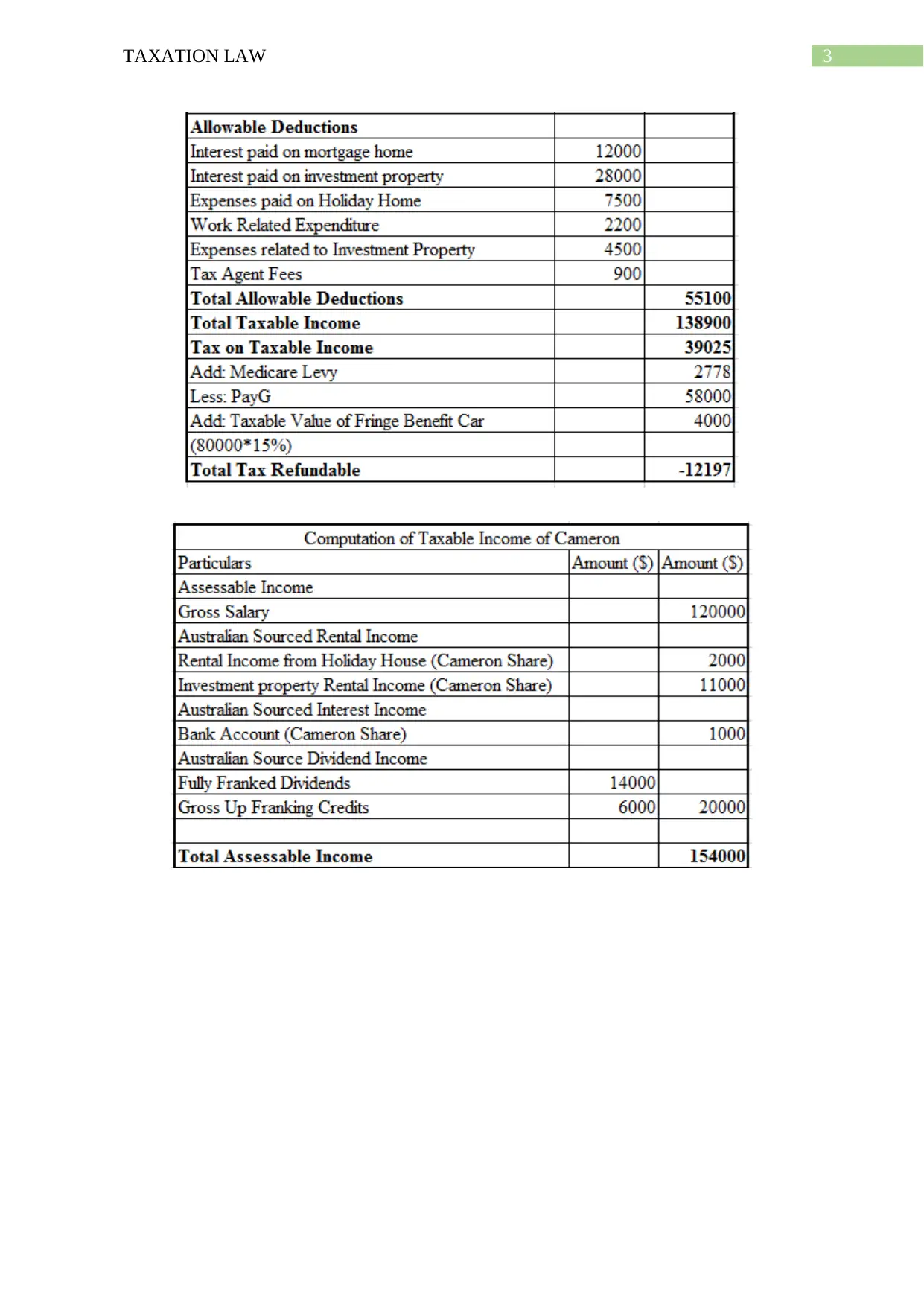
3TAXATION LAW
Paraphrase This Document
Need a fresh take? Get an instant paraphrase of this document with our AI Paraphraser
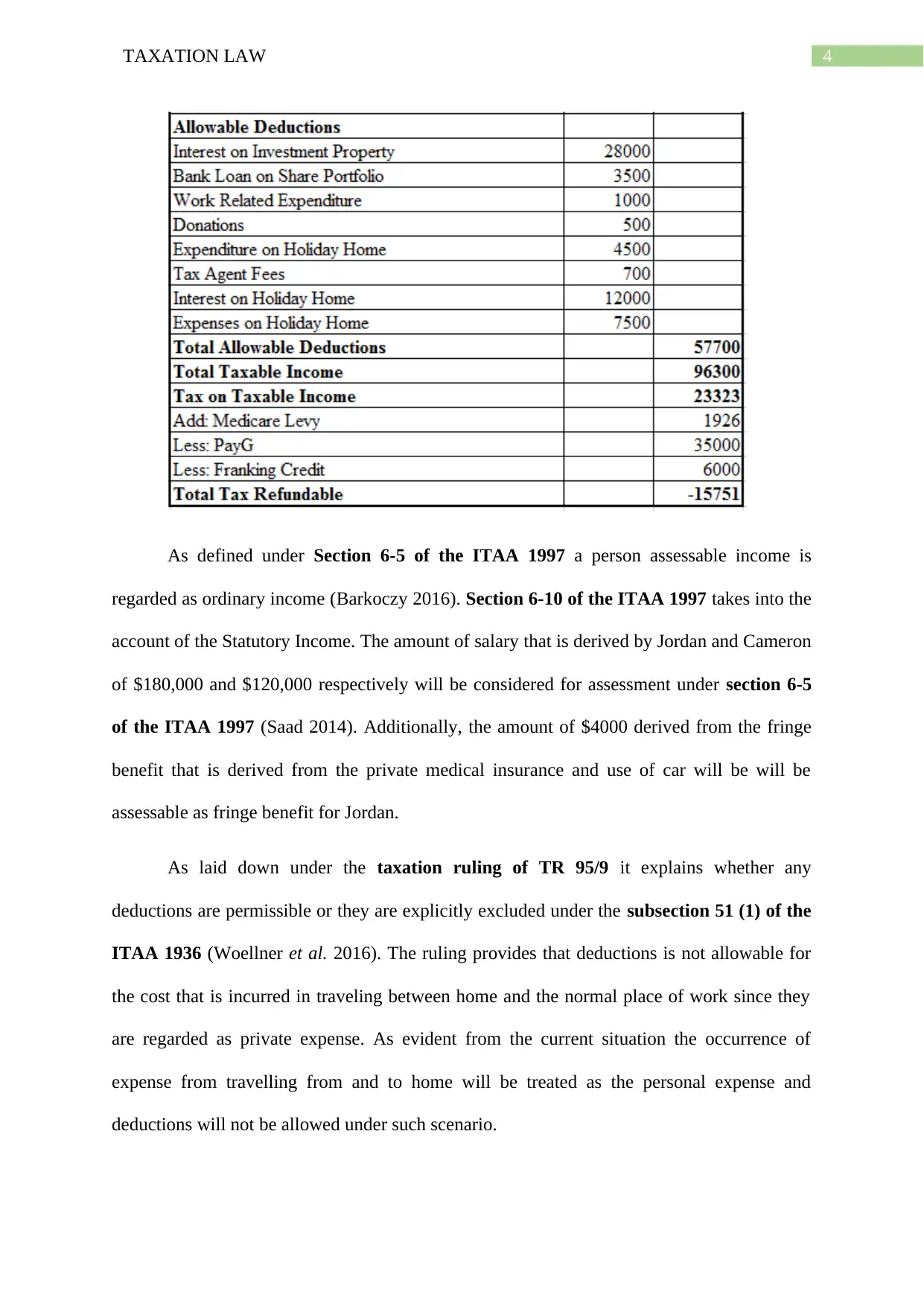
4TAXATION LAW
As defined under Section 6-5 of the ITAA 1997 a person assessable income is
regarded as ordinary income (Barkoczy 2016). Section 6-10 of the ITAA 1997 takes into the
account of the Statutory Income. The amount of salary that is derived by Jordan and Cameron
of $180,000 and $120,000 respectively will be considered for assessment under section 6-5
of the ITAA 1997 (Saad 2014). Additionally, the amount of $4000 derived from the fringe
benefit that is derived from the private medical insurance and use of car will be will be
assessable as fringe benefit for Jordan.
As laid down under the taxation ruling of TR 95/9 it explains whether any
deductions are permissible or they are explicitly excluded under the subsection 51 (1) of the
ITAA 1936 (Woellner et al. 2016). The ruling provides that deductions is not allowable for
the cost that is incurred in traveling between home and the normal place of work since they
are regarded as private expense. As evident from the current situation the occurrence of
expense from travelling from and to home will be treated as the personal expense and
deductions will not be allowed under such scenario.
As defined under Section 6-5 of the ITAA 1997 a person assessable income is
regarded as ordinary income (Barkoczy 2016). Section 6-10 of the ITAA 1997 takes into the
account of the Statutory Income. The amount of salary that is derived by Jordan and Cameron
of $180,000 and $120,000 respectively will be considered for assessment under section 6-5
of the ITAA 1997 (Saad 2014). Additionally, the amount of $4000 derived from the fringe
benefit that is derived from the private medical insurance and use of car will be will be
assessable as fringe benefit for Jordan.
As laid down under the taxation ruling of TR 95/9 it explains whether any
deductions are permissible or they are explicitly excluded under the subsection 51 (1) of the
ITAA 1936 (Woellner et al. 2016). The ruling provides that deductions is not allowable for
the cost that is incurred in traveling between home and the normal place of work since they
are regarded as private expense. As evident from the current situation the occurrence of
expense from travelling from and to home will be treated as the personal expense and
deductions will not be allowed under such scenario.
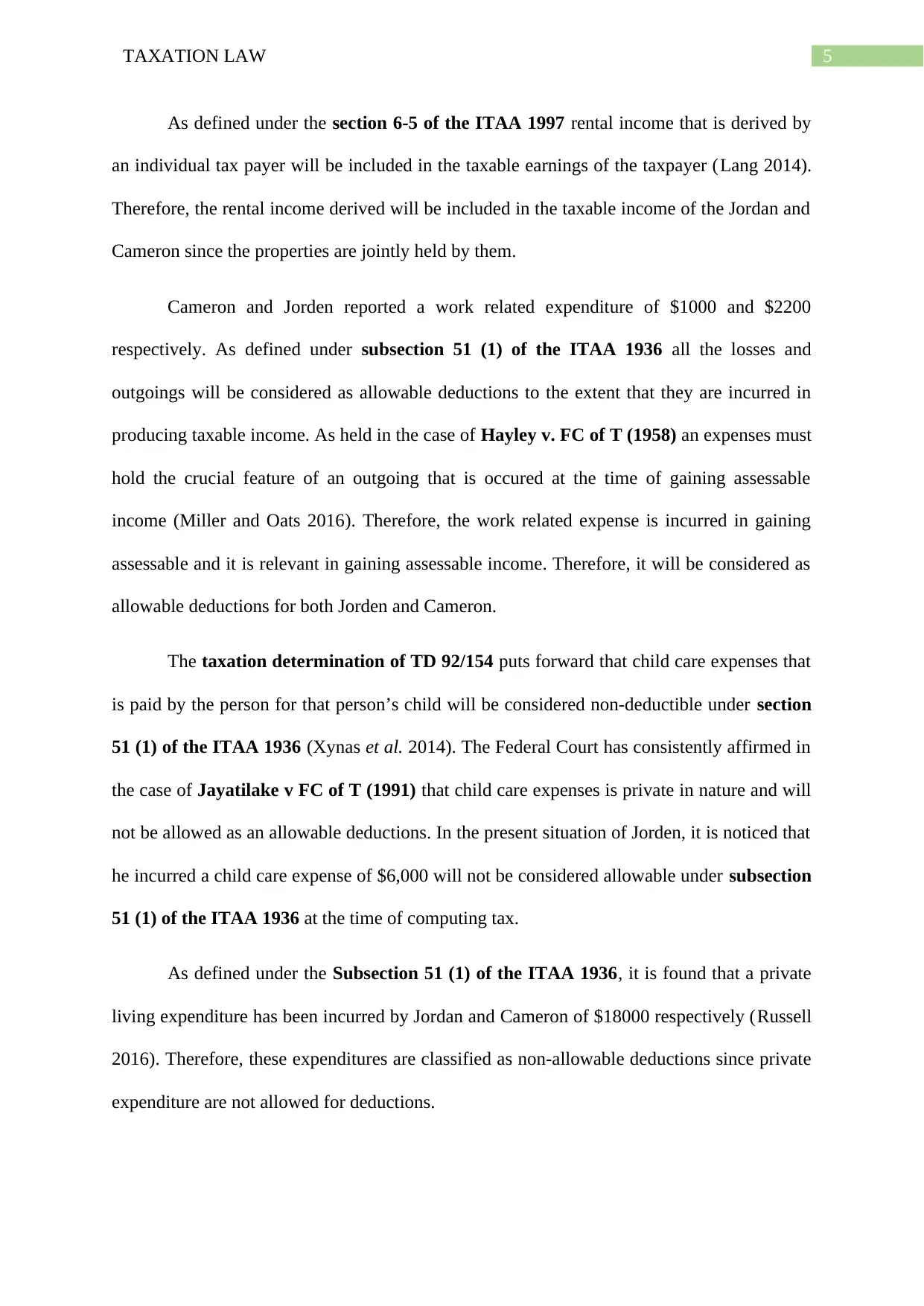
5TAXATION LAW
As defined under the section 6-5 of the ITAA 1997 rental income that is derived by
an individual tax payer will be included in the taxable earnings of the taxpayer (Lang 2014).
Therefore, the rental income derived will be included in the taxable income of the Jordan and
Cameron since the properties are jointly held by them.
Cameron and Jorden reported a work related expenditure of $1000 and $2200
respectively. As defined under subsection 51 (1) of the ITAA 1936 all the losses and
outgoings will be considered as allowable deductions to the extent that they are incurred in
producing taxable income. As held in the case of Hayley v. FC of T (1958) an expenses must
hold the crucial feature of an outgoing that is occured at the time of gaining assessable
income (Miller and Oats 2016). Therefore, the work related expense is incurred in gaining
assessable and it is relevant in gaining assessable income. Therefore, it will be considered as
allowable deductions for both Jorden and Cameron.
The taxation determination of TD 92/154 puts forward that child care expenses that
is paid by the person for that person’s child will be considered non-deductible under section
51 (1) of the ITAA 1936 (Xynas et al. 2014). The Federal Court has consistently affirmed in
the case of Jayatilake v FC of T (1991) that child care expenses is private in nature and will
not be allowed as an allowable deductions. In the present situation of Jorden, it is noticed that
he incurred a child care expense of $6,000 will not be considered allowable under subsection
51 (1) of the ITAA 1936 at the time of computing tax.
As defined under the Subsection 51 (1) of the ITAA 1936, it is found that a private
living expenditure has been incurred by Jordan and Cameron of $18000 respectively (Russell
2016). Therefore, these expenditures are classified as non-allowable deductions since private
expenditure are not allowed for deductions.
As defined under the section 6-5 of the ITAA 1997 rental income that is derived by
an individual tax payer will be included in the taxable earnings of the taxpayer (Lang 2014).
Therefore, the rental income derived will be included in the taxable income of the Jordan and
Cameron since the properties are jointly held by them.
Cameron and Jorden reported a work related expenditure of $1000 and $2200
respectively. As defined under subsection 51 (1) of the ITAA 1936 all the losses and
outgoings will be considered as allowable deductions to the extent that they are incurred in
producing taxable income. As held in the case of Hayley v. FC of T (1958) an expenses must
hold the crucial feature of an outgoing that is occured at the time of gaining assessable
income (Miller and Oats 2016). Therefore, the work related expense is incurred in gaining
assessable and it is relevant in gaining assessable income. Therefore, it will be considered as
allowable deductions for both Jorden and Cameron.
The taxation determination of TD 92/154 puts forward that child care expenses that
is paid by the person for that person’s child will be considered non-deductible under section
51 (1) of the ITAA 1936 (Xynas et al. 2014). The Federal Court has consistently affirmed in
the case of Jayatilake v FC of T (1991) that child care expenses is private in nature and will
not be allowed as an allowable deductions. In the present situation of Jorden, it is noticed that
he incurred a child care expense of $6,000 will not be considered allowable under subsection
51 (1) of the ITAA 1936 at the time of computing tax.
As defined under the Subsection 51 (1) of the ITAA 1936, it is found that a private
living expenditure has been incurred by Jordan and Cameron of $18000 respectively (Russell
2016). Therefore, these expenditures are classified as non-allowable deductions since private
expenditure are not allowed for deductions.
⊘ This is a preview!⊘
Do you want full access?
Subscribe today to unlock all pages.

Trusted by 1+ million students worldwide
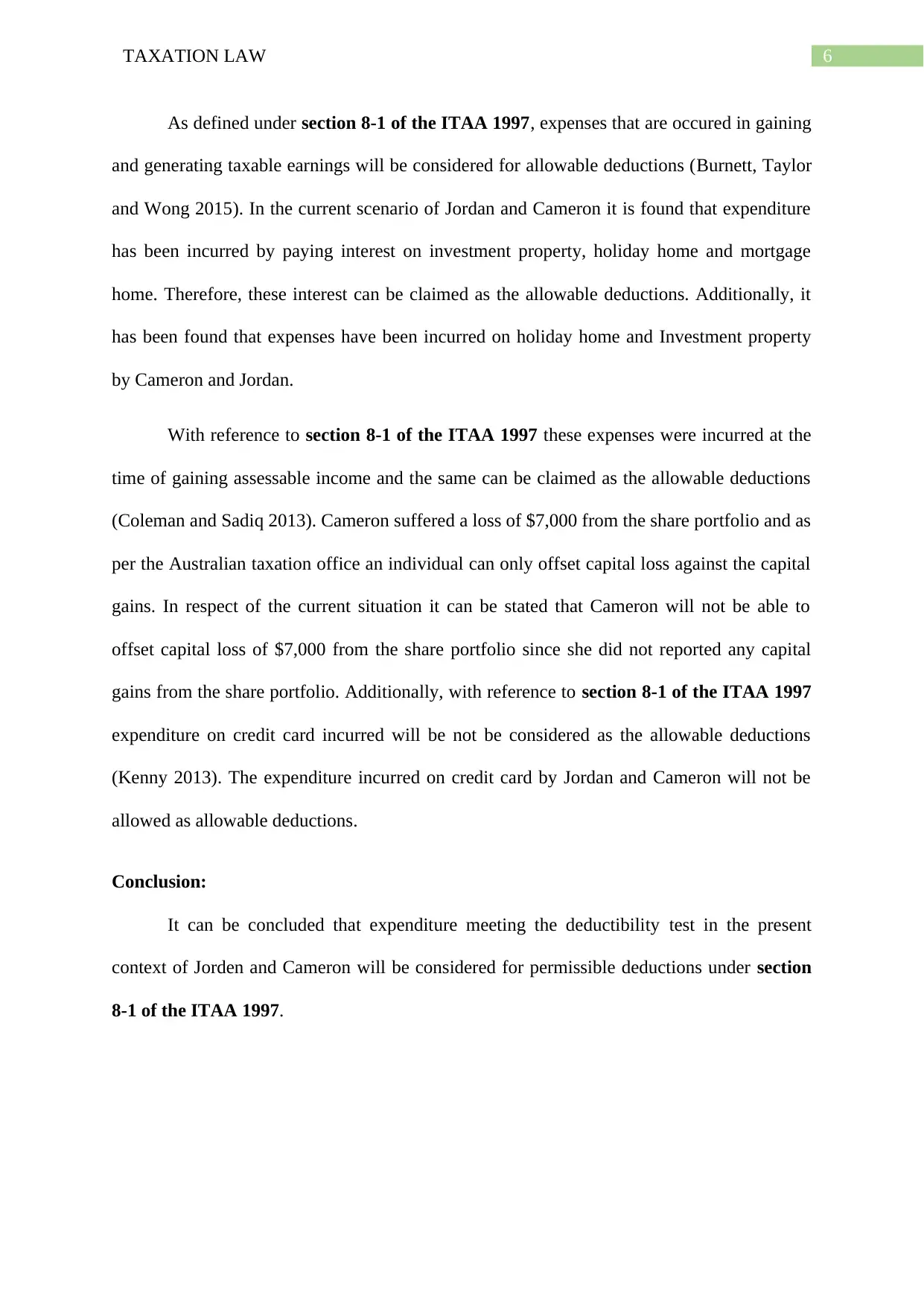
6TAXATION LAW
As defined under section 8-1 of the ITAA 1997, expenses that are occured in gaining
and generating taxable earnings will be considered for allowable deductions (Burnett, Taylor
and Wong 2015). In the current scenario of Jordan and Cameron it is found that expenditure
has been incurred by paying interest on investment property, holiday home and mortgage
home. Therefore, these interest can be claimed as the allowable deductions. Additionally, it
has been found that expenses have been incurred on holiday home and Investment property
by Cameron and Jordan.
With reference to section 8-1 of the ITAA 1997 these expenses were incurred at the
time of gaining assessable income and the same can be claimed as the allowable deductions
(Coleman and Sadiq 2013). Cameron suffered a loss of $7,000 from the share portfolio and as
per the Australian taxation office an individual can only offset capital loss against the capital
gains. In respect of the current situation it can be stated that Cameron will not be able to
offset capital loss of $7,000 from the share portfolio since she did not reported any capital
gains from the share portfolio. Additionally, with reference to section 8-1 of the ITAA 1997
expenditure on credit card incurred will be not be considered as the allowable deductions
(Kenny 2013). The expenditure incurred on credit card by Jordan and Cameron will not be
allowed as allowable deductions.
Conclusion:
It can be concluded that expenditure meeting the deductibility test in the present
context of Jorden and Cameron will be considered for permissible deductions under section
8-1 of the ITAA 1997.
As defined under section 8-1 of the ITAA 1997, expenses that are occured in gaining
and generating taxable earnings will be considered for allowable deductions (Burnett, Taylor
and Wong 2015). In the current scenario of Jordan and Cameron it is found that expenditure
has been incurred by paying interest on investment property, holiday home and mortgage
home. Therefore, these interest can be claimed as the allowable deductions. Additionally, it
has been found that expenses have been incurred on holiday home and Investment property
by Cameron and Jordan.
With reference to section 8-1 of the ITAA 1997 these expenses were incurred at the
time of gaining assessable income and the same can be claimed as the allowable deductions
(Coleman and Sadiq 2013). Cameron suffered a loss of $7,000 from the share portfolio and as
per the Australian taxation office an individual can only offset capital loss against the capital
gains. In respect of the current situation it can be stated that Cameron will not be able to
offset capital loss of $7,000 from the share portfolio since she did not reported any capital
gains from the share portfolio. Additionally, with reference to section 8-1 of the ITAA 1997
expenditure on credit card incurred will be not be considered as the allowable deductions
(Kenny 2013). The expenditure incurred on credit card by Jordan and Cameron will not be
allowed as allowable deductions.
Conclusion:
It can be concluded that expenditure meeting the deductibility test in the present
context of Jorden and Cameron will be considered for permissible deductions under section
8-1 of the ITAA 1997.
Paraphrase This Document
Need a fresh take? Get an instant paraphrase of this document with our AI Paraphraser
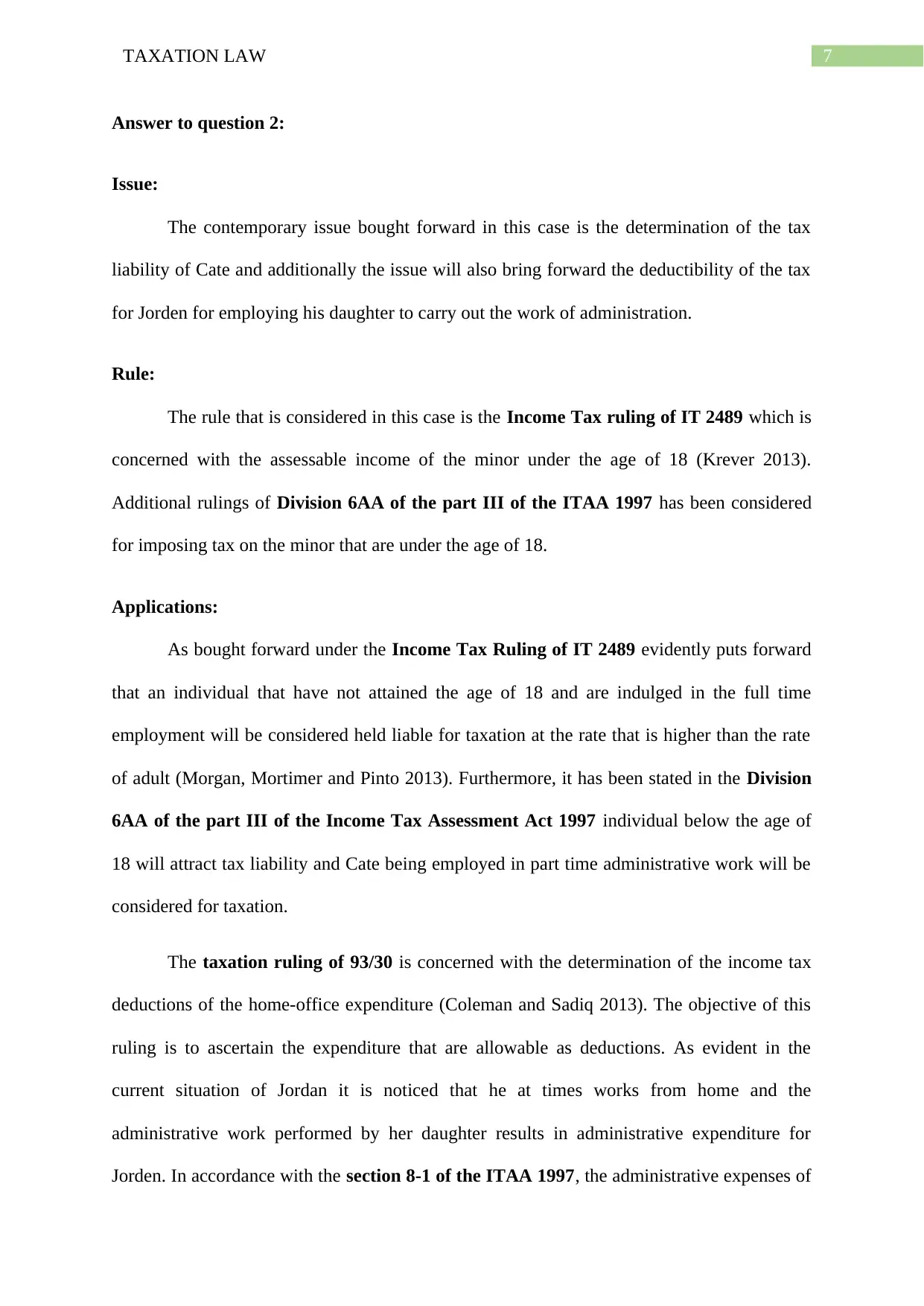
7TAXATION LAW
Answer to question 2:
Issue:
The contemporary issue bought forward in this case is the determination of the tax
liability of Cate and additionally the issue will also bring forward the deductibility of the tax
for Jorden for employing his daughter to carry out the work of administration.
Rule:
The rule that is considered in this case is the Income Tax ruling of IT 2489 which is
concerned with the assessable income of the minor under the age of 18 (Krever 2013).
Additional rulings of Division 6AA of the part III of the ITAA 1997 has been considered
for imposing tax on the minor that are under the age of 18.
Applications:
As bought forward under the Income Tax Ruling of IT 2489 evidently puts forward
that an individual that have not attained the age of 18 and are indulged in the full time
employment will be considered held liable for taxation at the rate that is higher than the rate
of adult (Morgan, Mortimer and Pinto 2013). Furthermore, it has been stated in the Division
6AA of the part III of the Income Tax Assessment Act 1997 individual below the age of
18 will attract tax liability and Cate being employed in part time administrative work will be
considered for taxation.
The taxation ruling of 93/30 is concerned with the determination of the income tax
deductions of the home-office expenditure (Coleman and Sadiq 2013). The objective of this
ruling is to ascertain the expenditure that are allowable as deductions. As evident in the
current situation of Jordan it is noticed that he at times works from home and the
administrative work performed by her daughter results in administrative expenditure for
Jorden. In accordance with the section 8-1 of the ITAA 1997, the administrative expenses of
Answer to question 2:
Issue:
The contemporary issue bought forward in this case is the determination of the tax
liability of Cate and additionally the issue will also bring forward the deductibility of the tax
for Jorden for employing his daughter to carry out the work of administration.
Rule:
The rule that is considered in this case is the Income Tax ruling of IT 2489 which is
concerned with the assessable income of the minor under the age of 18 (Krever 2013).
Additional rulings of Division 6AA of the part III of the ITAA 1997 has been considered
for imposing tax on the minor that are under the age of 18.
Applications:
As bought forward under the Income Tax Ruling of IT 2489 evidently puts forward
that an individual that have not attained the age of 18 and are indulged in the full time
employment will be considered held liable for taxation at the rate that is higher than the rate
of adult (Morgan, Mortimer and Pinto 2013). Furthermore, it has been stated in the Division
6AA of the part III of the Income Tax Assessment Act 1997 individual below the age of
18 will attract tax liability and Cate being employed in part time administrative work will be
considered for taxation.
The taxation ruling of 93/30 is concerned with the determination of the income tax
deductions of the home-office expenditure (Coleman and Sadiq 2013). The objective of this
ruling is to ascertain the expenditure that are allowable as deductions. As evident in the
current situation of Jordan it is noticed that he at times works from home and the
administrative work performed by her daughter results in administrative expenditure for
Jorden. In accordance with the section 8-1 of the ITAA 1997, the administrative expenses of
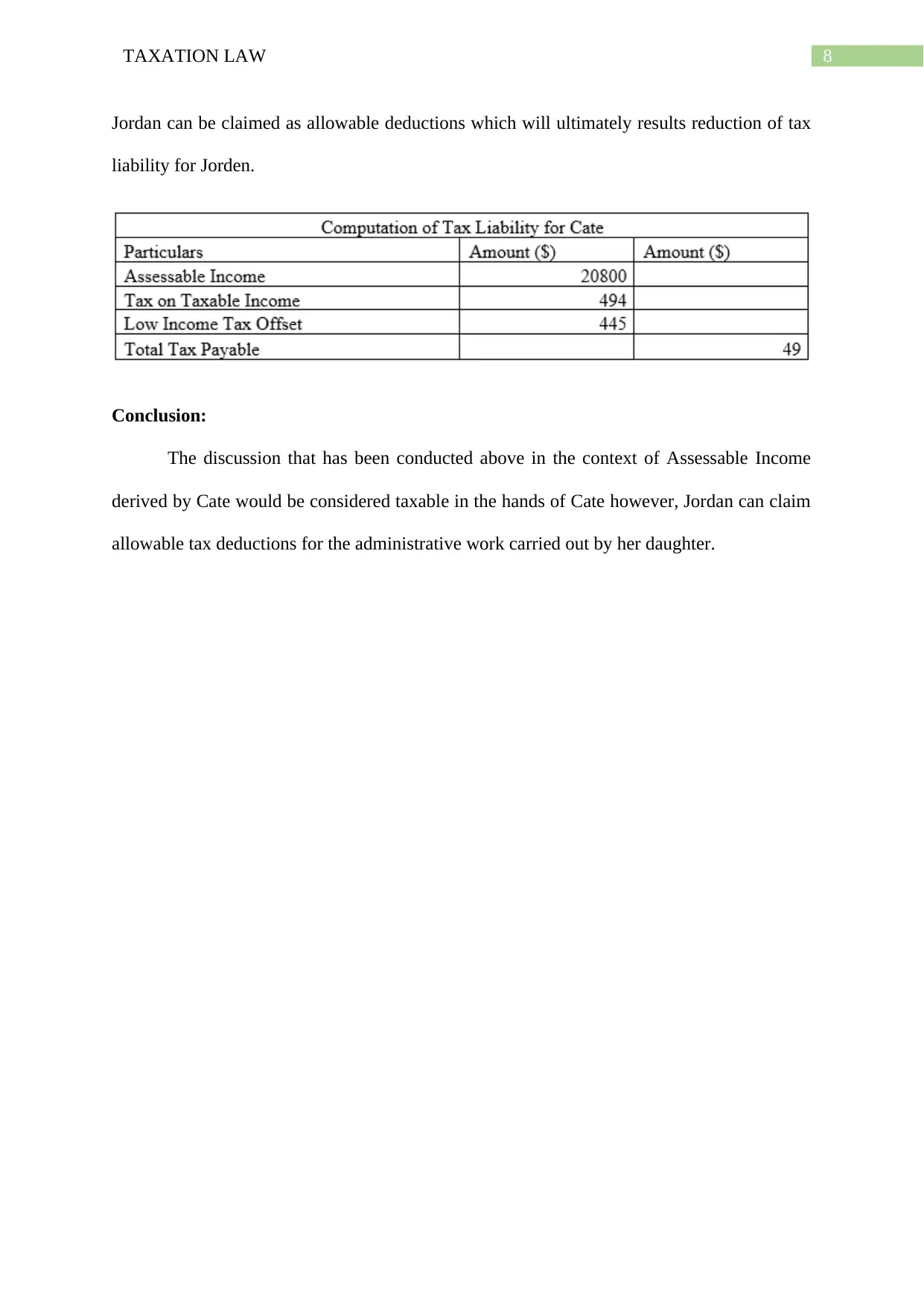
8TAXATION LAW
Jordan can be claimed as allowable deductions which will ultimately results reduction of tax
liability for Jorden.
Conclusion:
The discussion that has been conducted above in the context of Assessable Income
derived by Cate would be considered taxable in the hands of Cate however, Jordan can claim
allowable tax deductions for the administrative work carried out by her daughter.
Jordan can be claimed as allowable deductions which will ultimately results reduction of tax
liability for Jorden.
Conclusion:
The discussion that has been conducted above in the context of Assessable Income
derived by Cate would be considered taxable in the hands of Cate however, Jordan can claim
allowable tax deductions for the administrative work carried out by her daughter.
⊘ This is a preview!⊘
Do you want full access?
Subscribe today to unlock all pages.

Trusted by 1+ million students worldwide

9TAXATION LAW
Reference List:
Barkoczy, S., 2016. Foundations of Taxation Law 2016. OUP Catalogue.
Burnett, C., Taylor, C.J. and Wong, J., 2015. Qualification of Taxable Entities and Treaty
Protection: National Report for Australia.
Coleman, C. and Sadiq, K. (n.d.). Principles of taxation law 2013.
Kenny, P. (2013). Australian tax 2013. Chatswood, N.S.W.: LexisNexis Butterworths.
Krever, R. (2013). Australian taxation law cases 2013. Pyrmont, N.S.W.: Thomson Reuters.
Lang, M., 2014. Introduction to the law of double taxation conventions. Linde Verlag GmbH.
Miller, A. and Oats, L., 2016. Principles of international taxation. Bloomsbury Publishing.
Morgan, A., Mortimer, C. and Pinto, D. (2013). A practical introduction to Australian
taxation law. North Ryde [N.S.W.]: CCH Australia.
Russell, T., 2016. Trust beneficiaries and exemptions from CGT: Reflections on the Oswal
litigation. Taxation in Australia, 51(6), p.296.
Saad, N., 2014. Tax knowledge, tax complexity and tax compliance: Taxpayers’
view. Procedia-Social and Behavioral Sciences, 109, pp.1069-1075.
Woellner, R., Barkoczy, S., Murphy, S., Evans, C. and Pinto, D., 2016. Australian Taxation
Law 2016. OUP Catalogue.
Xynas, L., Blissenden, M., Villios, S. and Kenny, P., 2014. Allowable deductions, cost base
of CGT assets and the GAAR: a minefiled for taxpayers and their advisers. Australian Tax
Law Bulletin, 1(5), pp.94-98.
Reference List:
Barkoczy, S., 2016. Foundations of Taxation Law 2016. OUP Catalogue.
Burnett, C., Taylor, C.J. and Wong, J., 2015. Qualification of Taxable Entities and Treaty
Protection: National Report for Australia.
Coleman, C. and Sadiq, K. (n.d.). Principles of taxation law 2013.
Kenny, P. (2013). Australian tax 2013. Chatswood, N.S.W.: LexisNexis Butterworths.
Krever, R. (2013). Australian taxation law cases 2013. Pyrmont, N.S.W.: Thomson Reuters.
Lang, M., 2014. Introduction to the law of double taxation conventions. Linde Verlag GmbH.
Miller, A. and Oats, L., 2016. Principles of international taxation. Bloomsbury Publishing.
Morgan, A., Mortimer, C. and Pinto, D. (2013). A practical introduction to Australian
taxation law. North Ryde [N.S.W.]: CCH Australia.
Russell, T., 2016. Trust beneficiaries and exemptions from CGT: Reflections on the Oswal
litigation. Taxation in Australia, 51(6), p.296.
Saad, N., 2014. Tax knowledge, tax complexity and tax compliance: Taxpayers’
view. Procedia-Social and Behavioral Sciences, 109, pp.1069-1075.
Woellner, R., Barkoczy, S., Murphy, S., Evans, C. and Pinto, D., 2016. Australian Taxation
Law 2016. OUP Catalogue.
Xynas, L., Blissenden, M., Villios, S. and Kenny, P., 2014. Allowable deductions, cost base
of CGT assets and the GAAR: a minefiled for taxpayers and their advisers. Australian Tax
Law Bulletin, 1(5), pp.94-98.
Paraphrase This Document
Need a fresh take? Get an instant paraphrase of this document with our AI Paraphraser

10TAXATION LAW
1 out of 11
Related Documents
Your All-in-One AI-Powered Toolkit for Academic Success.
+13062052269
info@desklib.com
Available 24*7 on WhatsApp / Email
![[object Object]](/_next/static/media/star-bottom.7253800d.svg)
Unlock your academic potential
Copyright © 2020–2025 A2Z Services. All Rights Reserved. Developed and managed by ZUCOL.





![Taxation Law: Spriggs v Federal Commissioner of Taxation [2007]](/_next/image/?url=https%3A%2F%2Fdesklib.com%2Fmedia%2Fdocument%2Fpages%2Fspriggs-taxation-law-case-page-2.jpg&w=256&q=75)